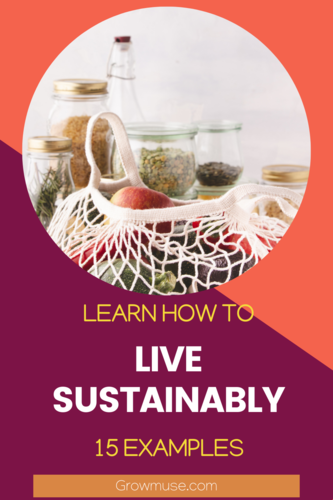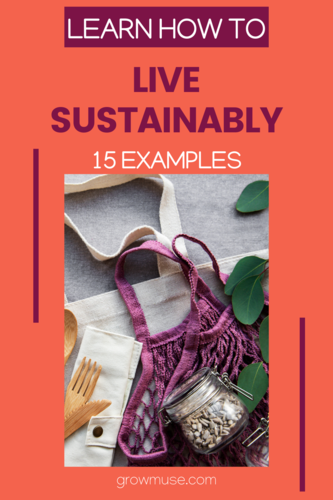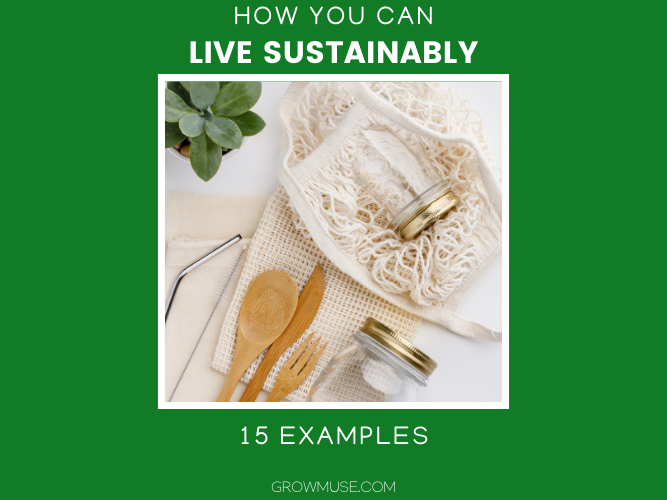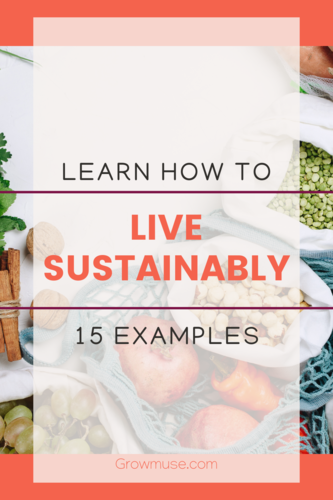
Any links on this page that lead to products on Amazon are affiliate links and I earn a commission if you make a purchase. Thanks in advance for your support! Read the full disclosure here.
Want to know why it’s important to live sustainably in 2021? Well, temperatures around the world have reached record highs. People all over the globe have suffered from floods, landslides, heatwaves, wildfires, or droughts.
The number of billion-dollar disasters in the US set a new record in 2020. Hurricane Laura cost the US $12 billion in damages!
If you want your children and future generations to live in a better world, you should learn how to live sustainably.
Table of Contents
What Is Sustainable Living?
You need to think about what you eat, how you get around, how much waste you contribute to landfills, and how much energy you’re using.
Sustainable living is about reducing your environmental impact. This means using fewer resources and fossil fuels.
Sustainable Living Examples
There are so many changes you can make to live sustainably. For example, there are cleaning, bath & body, makeup, and household products you can swap that are sustainable.
I’m not going to cover everything in this post. Rather, I’ll focus on sustainable practices as they relate to the food we eat.
Buy Food That Is In Season
In the past, I would pick recipes to cook for the week and then go to the grocery store to buy all of the ingredients for those recipes. I wouldn’t think twice about it.
Grocery stores spoil us, delivering food year-round. A lot of this food isn’t grown locally where we live. They’re shipped from hundreds, if not thousands of miles away.
That’s why in my state of Virginia, I can buy strawberries literally any month of the year, even though it’s only grown here in April, May, and June. Those strawberries in the store likely traveled all the way from California.
Strawberries shipped across the country means more fuel and carbon released in the atmosphere. This is why buying produce out of season contributes to climate change.
The last benefit helps your wallet. You’ll want to buy in-season produce as they cost less.
How Do You Know What’s In Season?
When I decided to start eating in season, it wasn’t easy. I had no idea what was grown when in my climate. I was constantly Googling recipes to see if the ingredients were in season or not.
This Seasonal Food Guide makes it so easy for you to choose in season produce.
The data comes from the Natural Resources Defense Council, USDA, state agriculture extension offices, and state departments of agriculture.
- Search what’s in season at any time of year in each of the 50 states
- Seasonality data accurate to half-month increments.
For example, if I use the tool and select Virginia, and early January in the dropdowns, this is what shows as being in-season for me to eat.
- Apples
- Carrots
- Celery Root
- Cilantro
- Fennel
- Horseradish
- Kohlrabi
- Lamb’s Quarters
- Leeks
- Lettuce
- Mint
- Mushrooms
- Oregano
- Parsley
- Purslane
- Rapini
- Sage
- Salsify
- Sorrel
- Sprouts
- Sunchokes
- Sweet Potatoes
- Turnips
See What’s In Season For Your Location
You give it a try and see what the app tells you to feed your body the best seasonal food at any time of the year.
Download the Seasonal Food Guide App: iOS and Android
Benefits of Buying Locally to Live Sustainably
The environmental footprint of harvesting local produce is much smaller than that of produce shipped from another country or state.
Another benefit of buying local is supporting your farmers and your local community. Help your hometown economy thrive!
If you care about your body, you’ll want to eat locally and seasonally as well.
Food harvested closest to you is the most nutrient-dense. It’s also giving your body the nutrients it needs for that season. In the cold winters you’ll want root vegetables filled with starches and in the hot summers you’ll want cooler fruits to nourish your body.
Buy Organic Food
I’ve heard some people say that their grandparents are healthy and they never had to buy organic. Why should we start eating organic now?
For one, farming has changed since our grandparents’ time as we shifted to monoculture farming.
“Instead of rotating different crops to naturally restore the nutrients and vitamins that are found in the soil, monoculture farming causes the same nutrients to diminish from the ground.”
Source: One Green Planet
How do farms plant carrots year after year without planting anything else to revitalize the soil?
They use chemical fertilizers, herbicides, and pesticides to kill weeds and insects.
Compare this to organic farming methods where they don’t use chemicals and are able to conserve water, use less energy, and reduce soil erosion.
Want some data?
This study looked at nutrient content data for 43 garden crops between 1950 and 1999.
Six nutrients showed reliable declines in presence at up to 38%. The six in decline were protein, Ca, P, Fe, riboflavin, and ascorbic acid.
Subscribe to Your Local Farmers Vegetable Box
If you don’t have time to shop for local produce and groceries, try a CSA program. Community Supported Agriculture (CSA) is a way for you to buy local, seasonal food directly from a particular farmer.
If you live in the DC Metro area, I highly recommend 4P Foods. We receive farm-fresh, seasonal food weekly.
4P Foods works with more than 200 local farmers offering high quality produce, meat, and dairy products. The extensive farmer network means you get a ton of variety too!
4P Foods is dedicated to helping the environment by partnering with farmers who use low-impact, sustainable methods of food production.
Getting seasonal food delivered straight to your door also forces you to try new produce.
In the past, I shopped for my recipes. Now I choose recipes based on seasonal produce in my 4P Bag. We order the small produce bag for our family for three.
It’s become much faster and easier to prep meals for my family. Eliminate the choices you need to make. Save time finding recipes and shopping for ingredients.
Use a vegetable CSA!
Want to try 4P Bags? When you sign-up, you’ll get $10 off your first order with 4PFoods. Simply add my name, PK, to the “referral” line during checkout.
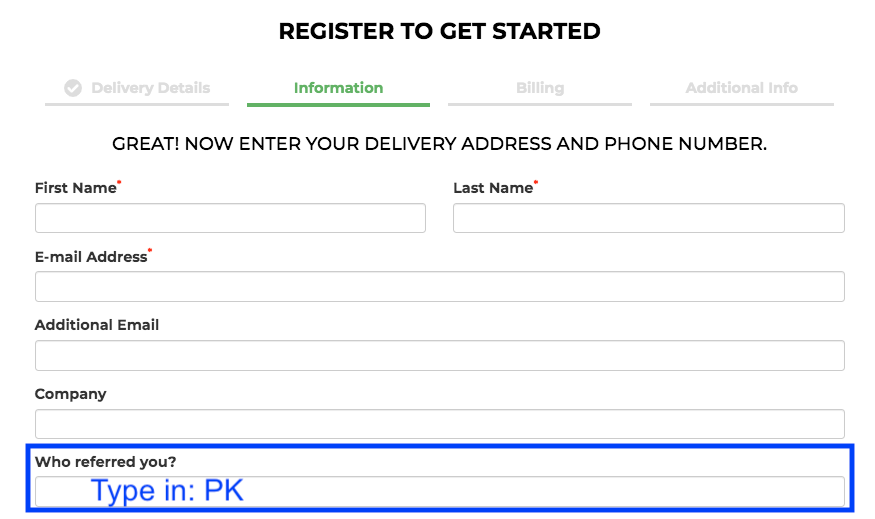
Eat More Vegetables
You can reduce your environmental impact through the food choices you make. I’m not claiming to be vegan. I do eat sustainably sourced meat products, but I eat a ton of vegetables and fruits too.
“Scientists estimate that all agriculture is responsible for approximately a quarter of all global anthropogenic greenhouse gas emissions. Animal agriculture is estimated to account for up to 80% of this number.”
Source: Earthday.org
Meat production requires a ton of resources:
- 1,800 gallons of water to produce a single pound of beef
- The leading cause of deforestation is animal agriculture
- 2 billions tons of manure produced from livestock. Much of which is kept in open environments on top of chemicals and then sprayed on farms as fertilizer
- The EPA claims US livestock production and waste are the largest contributor of methane emissions
Grow Your Own Herbs
Growing herbs is the easiest way to start growing your own food at home.
If you need a handful of cilantro, you can cut some right at home. No more going to the store to buy a bunch of cilantro when a recipe calls for a few tablespoons.
Get started with the Gardenuity Herb Garden Kit. Includes everything you need to grow your own herbs at home.
Grow Your Own Vegetables
Growing your own vegetables doesn’t mean buying some farmland.
Start small. You can grow food in a south-facing window. You can grow in containers on a balcony. If you have more land, set up a raised garden.
Learn how to set up your outdoor garden here. This is what I did the very first year I started growing food. You can too!
Cook at Home
If you have the time, cook most of your meals at home.
We try to support our local restaurants and order takeout on the weekends. During the week, however, it’s all about meal prep.
Simplifying your meal prep time by joining a CSA. We recommend 4PFoods if you’re in the DC Metro area. They include recipes along with the produce provided in your bag on a weekly basis too!
Preserve Your Food
I’ve talked about how in-season produce is less expensive at the grocery store. If you stock up, you could save a few bucks down the road on your favorite ingredients. This only works if you know how to properly preserve your food through canning, freezing, or dehydrating.
The National Center for Home Food Preservation is a great starting point for beginners to practice living more sustainably. They provide the basics for canning, freezing, and drying food.
Here are some top food blogs on the topics too.
Learn to Can Your Food Blogs
- Food In Jars: Canning recipes, books, and interesting ways to use preserves
- Simply Canning: Learn about canning vegetables, meat, fruit, and more through free and paid online workshops
- Canning and Cooking at Home: Gather safe canning recipes (water-bath, steam & pressure canning)
Learn to Freeze Your Food Blogs
- The Family Freezer: Freezer meal plans, cookbooks and ebooks for purchase. Join the newsletter to receive recipes, tips, freebies. Spend one hour prepping meals on the weekend and you’re done!
- Once A Month Meals: Free online training for freezer cooking and meal prepping. Know what food freezes well, how to save money, and freezer cook the easy way.
Rather than use plastic bags, try some reusable ones that last!
Learn to Dehydrate Your Food Blogs
- Easy Food Dehydrating: New information on safely dehydrating food, updates and offers on eBooks & Udemy video courses. There’s a free eBook on 6 Simple Steps to dehydrate food and store them properly.
- Dehydrate2Store: Articles, books, videos, tips, and giveaways! They offer a ton of videos on getting started, creating meals, snacks, and drinks.
I love this dehydrator because it’s great for compact spaces!
Reusable Grocery Bags and Produce Bags
Have you already made the switch to paper or bring your own reusable bags to the grocery store or farmers’ market? Great!
What about when you’re in the produce section? Do you bag up your lettuce, apples, and limes?
STOP!
There’s no need to bag your produce. Toss it in the cart naked. You’re going to wash them at home anyway. There’s no need to bag it for the 30 minutes you’re at the store.
Plastic bags end up in our waterways and landfills. Animals mistake plastic as food. This means some of the fish you eat could have plastic. You’re ingesting plastic too!
If you are big on organization and must bag your produce, at least opt for a reusable produce bag.
I got one like below for free during an environmental seminar my county held.
Buy In Bulk
I love to buy seeds, beans, and oats in bulk. They save a ton of money!
Some stores have compostable bags available for you to use if you’re buying bulk.
You can also bring your own containers to fill up in the bulk aisle.
Make sure you follow these instructions if you’ve never done this.
- Go to customer service or a cashier to get the tare weight on your empty containers
- Label the tare weight with a permanent marker so you don’t have to do this every time you shop
- After filling up your bulk item, use your phone’s camera to take a picture of the weight and cost. There’s no need to print out a label at this point.
- When you’re checking out, show the cashier your jar, and the photo of the item after you weighed it.
- The cashier will subtract the tare weight of the container from the total weight with the bulk item filled inside the container.
Reusable Napkins
Do you use disposable paper napkins?
If you eat three meals a day, you’re tossing out 1,095 paper napkins into the trash. That’s a lot of waste!
I used to do this too. I’d either buy packs of napkins or tear off a piece of a paper towel roll.
Then I switched to linen napkins. Not only do they look prettier, they last longer, and you don’t have to toss them.
Linen is made from fibers of the flax plant and much more environmentally friendly than certain types of cotton.
Tip: Fold the napkin around to the sides you haven’t touched after meals, and they can get you through a few days! It’s still sanitary.
Laundering linen napkins in cold water with biodegradable and phosphate-free laundry soap, and then line drying, reduces the impact of washing and conserves energy.
We love these linen napkins from Parachute.
Here’s another, more affordable option from Amazon.
Reusable Water Bottle
Plastic bottles are resource-intensive to manufacture, fill, and ship. They also pollute our land and leach chemicals into your water if left to sit for a long time or exposed to heat.
Choose a reusable bottle made of glass. Metal water bottles are also a good option. Metal makes it easy to carry everywhere without worrying about them shattering.
Reusable Straws
Single-use plastics are terrible for the environment. They end up in our oceans, in our fish, gross! Americans use about 500 million plastic straws every day.
Try carrying around a reusable straw. They make them so they fit into tiny carrying cases. I bring a few when we travel because our daughter loves her straws.
Here’s was we use from Food52!
If you prefer to shop on Amazon, this product is similar.
Reusable Containers
Slowly ditch the plastic containers and use glass or metal to store your food.
These are great for meal prep, packing kids’ lunches and snacks, or bringing food to the office.
Bamboo Toothbrush
I used to be all about my electric toothbrush. Then I found out an estimated 1 billion plastic toothbrushes are thrown away each year. I think this includes the electric toothbrush heads. And that’s just in the USA!
I made the switch to OraWellness, a company that created the first eco-friendly toothbrush with a Bass design.
They also donate 100% of the profits from BrushEco sales to organizations that are committed to creating and implementing solutions to our global plastic problem.
These brushes are sustainable because BrushEco is made of 99.97% biodegradable and compostable materials.
Final Thoughts
There are 7.8 billion people in the world. If each one of us made small adjustments in our daily lives, we could move the needle. You are wrong if you think it takes big corporations or governments to initiate changes that will help the environment and economy.
It starts with YOU.
Buy in season produce. Support your local farmers. Preserve your food. Reduce your plastic use.
Vote with your dollar. Spend your money where it counts.
Commit to making these small changes. If you know it’s important, you’ll stick with it. This is a New Year’s resolution worth keeping!
Let me know in the comments what changes you’ve made or want to make to live more sustainably.
Growmuse.com is a participant in the Amazon Services LLC Associates Program, an affiliate advertising program designed to provide a means for sites to earn commission by linking to Amazon.com. This is done at no cost to you. Read the full disclosure here.
Pin this article if you want to save it for later!
